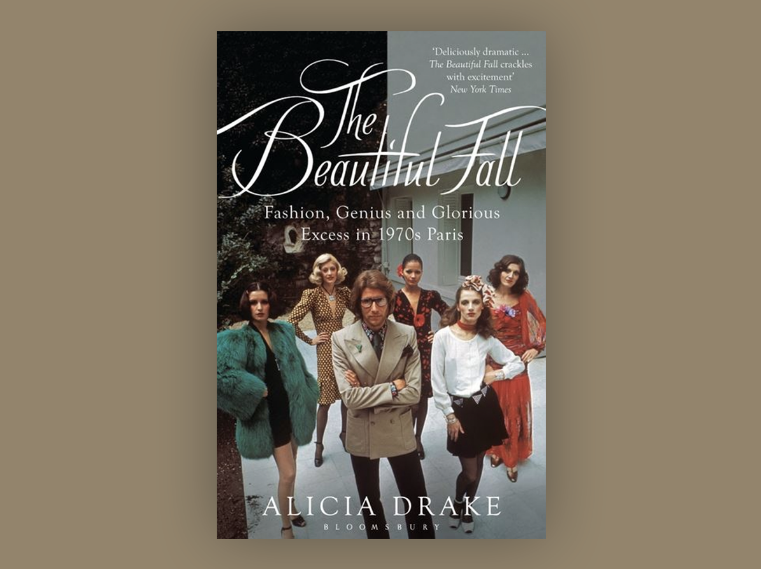Book Review: The Beautiful Fall: Fashion, Genius and Glorious Excess in 1970s Paris
Alicia Drake, The Beautiful Fall: Fashion, Genius and Glorious Excess in 1970s Paris, Bloomsbury, £12.99, 448 pp., October 2007
The Beautiful Fall: Fashion, Genius and Glorious Excess in 1970s Paris is not a new book. Originally published ten years ago, Alicia Drake’s chronicle of fashion demigods Karl Lagerfeld and Yves Saint Laurent remains relevant as major fashion houses continue to rule the industry.
An entertaining account of Lagerfeld and Saint Laurent’s entangled ascent to fashion stardom, the book follows the pair from their schoolboy rivalry turned full blown turf war, as well as their eventual wild success. Drake’s reconstruction of the 70s Paris of the designers’ youth builds on a foundation of extensive interviews and a truly impressive showing of detailed research. Drake recreates atelier drama, underground Parisian parties at Le Sept, and cocaine-fueled ragers at Jacques de Bascher’s many rented homes, down to the accessories worn and drinks served. Whatever there is of conjecture in these accounts remains undetectable.
Drake’s recounting succeeds thanks to her heavily gilded cast of interviewees. Insights from the likes of Andre Leon Talley, Loulou de la Falaise, Paloma Picasso, and Pierre Bergé, among many others, serve to fill any narrative gaps and dazzle enough to distract from the volume’s most glaring omission: the voices of Lagerfeld and Saint Laurent. Published in 2006 and therefore before Saint Laurent’s passing—as well as a moment in which the house still bared his full name—the absence of his voice and Lagerfeld’s feels frustrating at times, yet understandable. Throughout Drake’s narrative, one has the sense that both Saint Laurent and Lagerfeld, different as they were, valued the mysteries they so meticulously concocted. Both built their work atop their expertly crafted individual personas, Saint Laurent as the tragic genius, and Lagerfeld as a modern Germanic aristocrat.
Drake burrows into each designer’s backstory, both real and fictionalized, to fascinating effect. Her explorations reveal deeply contrasting stories, especially where Lagerfeld is concerned. His habit for self-aggrandizing is laid bare, occasionally to comical effect. Despite her tales of Lagerfeld’s openness (such as the fact he keeps a fax machine next to his bed and at the ready to speak to journalists at a moment’s notice) she also describes him as a vampiric, shape-shifting creature, sleeping in a mausoleum of a room (of his own design, of course) and subsisting only on steamed food and youth.
Saint Laurent’s portrayal goes similarly, his seeming physical frailty and helplessness contrasted with a strong, often self-destructive ego and hyper-intelligent mind. Drake treats Saint Laurent with a bit less sympathy, and so he often comes off as childlike and insulting to even his closest friends. And yet, some of his confidantes and co-workers insist on a deep kindness that is deeply embedded in his tumultuous personality.
For a book that demystifies so much of fashion’s glamour, Drake’s work builds the mystery surrounding its two central figures. With no voices of their own, Drake can only paint Saint Laurent and Lagerfeld through the reflections of others – creating a distorted, occasionally contradictory portrait. Both come out more enigmatic than before, heightening the allure of their names.
The Beautiful Fall serves as testament to a time and a place, documenting the “glorious excess” of the 70s and beyond. Figures like Jacques de Bascher (a long-time partner to Lagerfeld) and fashion illustrator Antonio Lopez are central to this part of the narrative, their glamourous personas shining tragically against their eventual deaths to the AIDS crisis. Saint Laurent and Lagerfeld were not the only stars in the era’s constellation, but as AIDS swept away a generation, they (unfairly) remain the brightest. People thirsting for glamour and beauty flocked to both designers like moths to a flame, yet few could ascend the pecking order and stand alongside the two behemoths for very long. Fashion is, as always, a calamitous world.
As demonstrated in the book, everyone’s turn at the zenith of Parisian fashion was built on the same groundwork as their eventual decline – a constant stream of scandal including lover’s quarrels, subterfuge, cocaine-doused motorcycles, friendships turned sour, public sexual acts, and what are probably grounds for multiple arrests. Better to shine for a moment than not at all, the mentality insists. Full of drama and detail, Beautiful Fall reads like a novel, but at nearly 400 pages the delicious thrill eventually fizzles. Even an excess of excess can make for a dull read, luckily the bulk is an engaging tale of two designers turned cultural icons whose visions continue to shape the fashion industry.



